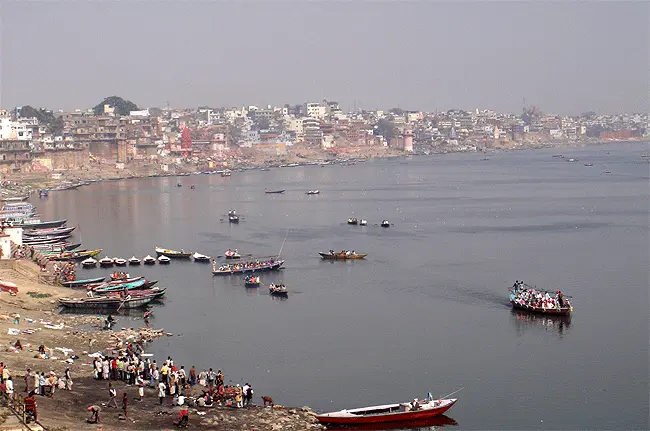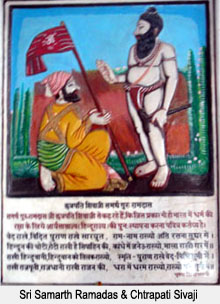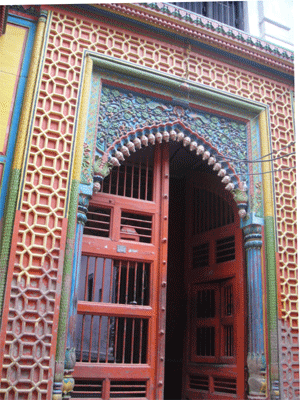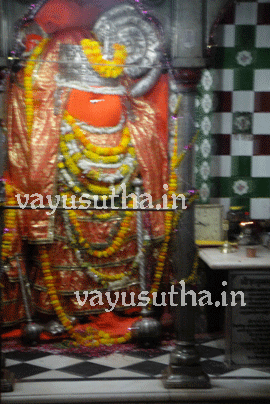
Varanasi
According to the 'Vamana Purana', the Varuna and Assi are two rivers that originated from the body of the primordial Purusha. The tract of land lying between the two rivers is believed to be 'Varanasi', the holiest of all pilgrimage centers - a city in existence from time immemorial that has enlightened many Rishis and Saints. The ante diluvian culture preserved by this great city is the standing testimony to the grandeur of the past. Varanasi is the microcosm of Hinduism, a city of traditional classical culture. Glorified by myth and legend and sanctified by religion, it has always attracted a large number of pilgrims and seekers of soul. The city is also known as 'Kasipuri' and the word 'Kas' means to shine.
Sanctity of this kshetra
 In its course of 2,525 km, the River Ganga flows northward [uttervahini] only here in Varanasi, which is why it is considered sacred. Every follower of Sanatana Dharma takes pride in visiting this holy city once in their lifetime and takes a holy dip in the River Ganga. It is a privilege for the people following dharma to perform the ceremony for their dead parents. It is believed that one gets liberated from the life cycle of birth and rebirth if he/she breathes their last in this holy kshetra.
In its course of 2,525 km, the River Ganga flows northward [uttervahini] only here in Varanasi, which is why it is considered sacred. Every follower of Sanatana Dharma takes pride in visiting this holy city once in their lifetime and takes a holy dip in the River Ganga. It is a privilege for the people following dharma to perform the ceremony for their dead parents. It is believed that one gets liberated from the life cycle of birth and rebirth if he/she breathes their last in this holy kshetra.
There are many holy men who have spent their lifetime here. This kshetra is known for bringing out the best of learning. Therefore every pundit took it upon himself to come here and prove the theory he is advocating. This is a seat of high learning.
Taking a bath in the Ghats of Varanasi is considered holy. There are people who come and live here to take baths in these holy Ghats and breathe their last.
Ghats of Varanasi
The Ghats that lay between the confluence of Assi with Ganga in the south and the confluence of Varuna in the north are the holiest. Taking a bath in these Ghats is considered holy and purifies one of all sins. The Ghats earlier were named Assi Ghat, Harischandra Ghat, etc. These Ghats have now been divided and named based on the people who lived there (Tulsi Ghat) or on temples in that stretch (Omkareshwar Ghat) and so on.
Over a period many maharajas of different regions had built guest houses for the people coming to Varanasi from their kingdom. Thus the Ghats had been renamed in the maharajas’ name or the kingdom they represent.
Hanuman Ghat
Hanuman Ghat is adjacent to Harichandra Ghat. The ancient name of this Ghat was Ramesvaram Ghat as per the seventeenth-century script ‘Geervaanapadhamajari’. But today the name Hanuman Ghat had come to stay. Today this Ghat is known because of the ‘Bade Hanuman’ present inside the Akhara here.
Saint Samarth Ramadas
 Samarth Ramadas, the saint from Maharashtra was adopted as Guru by Chatrapati Veera Sivaji. He was instrumental in the re-establishment of the rule of Sanatana. Under the able guidance of Samarth Ramadas Chatrapati Veera Sivaji could bring back much of the territory under his control. Aurangzeb the mogul ruler had converted most of his subjects to his faith and also destroyed all places of worship of other faiths. That was the time when Chatrapati Veera Sivaji rose against the policies adopted by the Mogul ruler to protect the Sanatana dharma of this land.
Samarth Ramadas, the saint from Maharashtra was adopted as Guru by Chatrapati Veera Sivaji. He was instrumental in the re-establishment of the rule of Sanatana. Under the able guidance of Samarth Ramadas Chatrapati Veera Sivaji could bring back much of the territory under his control. Aurangzeb the mogul ruler had converted most of his subjects to his faith and also destroyed all places of worship of other faiths. That was the time when Chatrapati Veera Sivaji rose against the policies adopted by the Mogul ruler to protect the Sanatana dharma of this land.
He drew inspiration for this from the teachings of Samarth Ramadas. Samarth Ramadas on his part as a devotee of Sri Rama had undertaken a long journey to various parts of the land preaching the bhakti towards Sri Rama and the necessity for the people to unite against adharma.
Sri Tulsidas during the early Mogul period had worked towards defusing the intolerance within the different sects of the Sanatana dharma. Samarth united the different groups to come together against the danger that the Sanatana Dharma was facing at that time.
Samarth drew a portrait of Sri Hanuman on a huge rock and his immediate disciple Sri Kalyan and others took the rock on their head. Samarth proceeded towards the Harichandra Ghat and placed the deity of Sri Hanuman on the platform under the banyan tree.
Saint Samarth at Kashi the Varanasi
Samarth, who had widely traveled the land, had also visited Varanasi after visiting Chitrakoot. He was followed by many saints and sanyasis from Chitrakoot to Varanasi. It is known that he had given prominence to ‘Surya Namaskaram’ and physical fitness along with discipline in habits. He was camping in Varanasi along with his band of followers and as a routine, they used to take baths in Ganga and go to nook and corner of the town and spread the glory of ‘Sri Rama nama’ and ask people to get united against adharma.
It was his routine that he would go to Sri Sankata Mochan Hanuman Mandir’ established by Sri Tulsidas and start his daily preaching in the town. The pundits of Varanasi saw that Samarth had many followers from the city itself, and so they wanted to know what is so special in his speech that people were attracted. They wanted to extend an invitation to Samarth to come for a discussion in the ‘Dharma Mahasabha’.
Samarth and Maha sabha of Kashi
 On that day when they were in Sankata Moochan Hanuman Mandir, Samarth drew a portrait of Sri Hanuman on a huge rock and his immediate disciple Sri Kalyan and others took the rock on their head. Samarth proceeded towards the Harichandra Ghat and placed the deity of Sri Hanuman on the platform under the banyan tree. They conducted prayers to the deity and sang bhajans before proceeding for their daily visit for ‘bhiksha’ in the town.
On that day when they were in Sankata Moochan Hanuman Mandir, Samarth drew a portrait of Sri Hanuman on a huge rock and his immediate disciple Sri Kalyan and others took the rock on their head. Samarth proceeded towards the Harichandra Ghat and placed the deity of Sri Hanuman on the platform under the banyan tree. They conducted prayers to the deity and sang bhajans before proceeding for their daily visit for ‘bhiksha’ in the town.
At that time a representative of Dharma Mahasabha came to extend an invitation for the discussion. The next day the pundits from Dharma Mahasabha came to meet Samarth and took him in procession along with divine hymns. Samarth was able to convince the pundits of Kashi, his point of view, the need of the hour, and thus the necessity for re-establishment of Sanatana dharma.
Bade Sri Hanuman of Kashi
The deity of Sri Hanuman established by Sri Samarth on the banks of Ganga in Harichandra Ghat is today known as Bade Hanuman. The Bade Hanuman is housed today inside Juna Akhara of Hanuman Ghat.
The portion of Harichandra Ghat where Sri Samarth had installed the deity of Sri Hanuman is today known as Hanuman Ghat. Such is the influence and power of this deity that the Ghat itself was renamed as Hanuman Ghat. He is known as Bade Hanuman since, the deity is huge in structure, fame, power, and in bestowing blessings.
Sri Hanuman deity is huge in structure and the whole deity is pasted with sendur. His right hand is seen giving blessings to His devotees, while a gadha is placed on His left hand. His huge tail which rises into a massive spiral is prominently seen. The huge tail of Sri Hanuman suggests that there is a mysterious magical power to the Lord Himself.
Location of the temple: Sri Bade Hanuman, Hanuman Ghat, Varanasi"
Experience
Come to this Bade Kshetra and the Hanuman Ghat. Offer prayers to Bade Hanuman established by Sri Samarth. The devotee is sure to gain confidence and courage to face any difficult situation in life.
SRI HANUMAN THINKS DIFFERENTLY, THINKS FAST
THINKS AHEAD AND ACTS FOR SURE
Ed [Sep 2020]
Updates: [Jan 2025]
